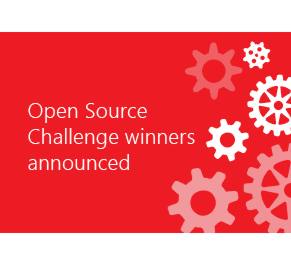| Microsoft Research Awards Demonstrate Commitment to Open Source |
| Written by Sue Gee | |||
| Saturday, 28 May 2016 | |||
|
The winners of Microsoft Research Open Source Challenge, a student contest to raise awareness of Microsoft Research and its open source tools, have been announced. Meanwhile Microsoft Research itself has been presented with an award from the IEEE Council that recognises both its collaboration with academia and commitment to open source software. The TCSE Distinguished Synergy Award is presented annually by the IEEE Computer Society Technical Council for outstanding and/or sustained contributions that stand as a model in the software engineering community of effective partnership between industry and universities. The history of Microsoft Research dates back to 1991 when Microsoft was one of the first software companies to create its own computer science research organization. Today Microsoft Research has more than 1,000 scientists and engineers who focus on a wide variety of research areas and openly collaborate with leading academic, government and industry researchers to advance the state of the art of computing and solve some of the world’s toughest problems through technological innovation. Software engineering spans its labs in Redmond, Washington, Cambridge, UK, India and Asia. The 2016 award made to Microsoft Research for its team-oriented approach toward common research goals acknowledges both the way it is perceived as an open research institution that enables and encourages its researchers to work in collaboration with academia and its commitment to open source software. Michael Ernst, now a professor in Computer Science and Engineering at the University of Washington and formerly a researcher at Microsoft Research made this comment about the extent and value of its open source software “Microsoft Research has made dozens of their tools available to researchers who have eagerly grasped them to avoid time-consuming work to reinvent the wheel. Some of these tools represent hundreds of person-years of work. This sharing of tools makes it easier to reproduce results and to make direct comparisons – without which rigorous science is impossible. In addition, Microsoft’s datasets are priceless. There is no other source for data about software development at such a large scale, done by such skilled practitioners. It has revolutionized our thinking about empirical studies." Given the amount and scope of the open software that Microsoft Research provides it tends to be underused due to lack of awareness of its existence. To try to increase visibility the recent Microsoft Open Source Challenge, which we reported back in February, was to promote both Microsoft Research and its open source tools. As Judith Bishop, Director of Computer Science, Microsoft Research, explained in her blog post announcing the outcome of the contest, the idea was: Put open source code and data into the hands of students. Give them free rein, just a few rules, a little incentive, and then watch them build with, and on top of Microsoft’s open source research software and tools. Over 650 students from all over the world took part and the grand prize winner, Akond Rahman, a second-year student in the computer science doctoral program at North Carolina State University, was among those who had been unaware of the resources at his disposal via the Microsoft Research Open Source Portal until the challenge was brought to his attention. The winning submission, “Quantifying Semantic Similarity of Software Projects Using Deep Semantic Similarity Model,” was a project being held up for lack of suitable machine learning tools. As Rahman puts in the the blog post: “Small teams of engineers working in large corporations [and institutions] are constantly having to start from scratch—they can’t get anything useful out of the software repositories. If I could use a deep learning neural network like DSSM to do the semantic search and arrange and score the tokens, teams would be able find and reuse code that other teams had already created.” Thanks to finding out about the contest Akond used the Send2Vec, which are the predictors and trained model files of DSSM (deep structured semantic model or deep semantic similarity model) to quantify the semantic similarity of software projects. Three second prizes were also awarded:
Judith Bishop sums up the success of the contest for the students, for Microsoft Research and for open source: The Open Source Challenge did exactly what we’d hoped: the winning students — some of whom hadn’t known about the offerings available through the Open Source for Academics program at Microsoft—found the tools they needed to solve real problems. At the same time, the Challenge has opened up to Microsoft’s researchers a new wave of developers who can engage and assist in taking their tools forward. Open source is far from just a mechanism for releasing code; it’s a means for building a community of users who are also developers and who care about the direction and quality of the product, whether large or small. With their fresh approach, students can play a key role in creating these communities and helping direct the products Microsoft cares about.
More InformationMicrosoft Open Source Challenge Microsoft Research Open Source Portal Related ArticlesMicrosoft Research Open Source Challenge For Students MIcrosoft's Project Oxford AI APIs For The REST Of Us To be informed about new articles on I Programmer, sign up for our weekly newsletter, subscribe to the RSS feed and follow us on, Twitter, Facebook, Google+ or Linkedin.
Comments
or email your comment to: comments@i-programmer.info . |
|||
| Last Updated ( Saturday, 28 May 2016 ) |


